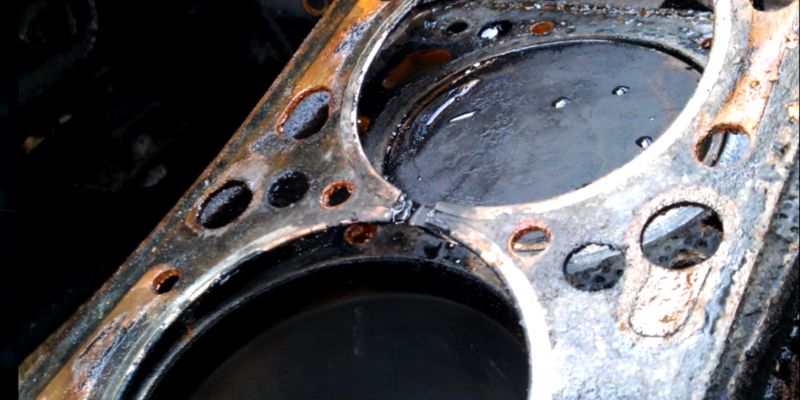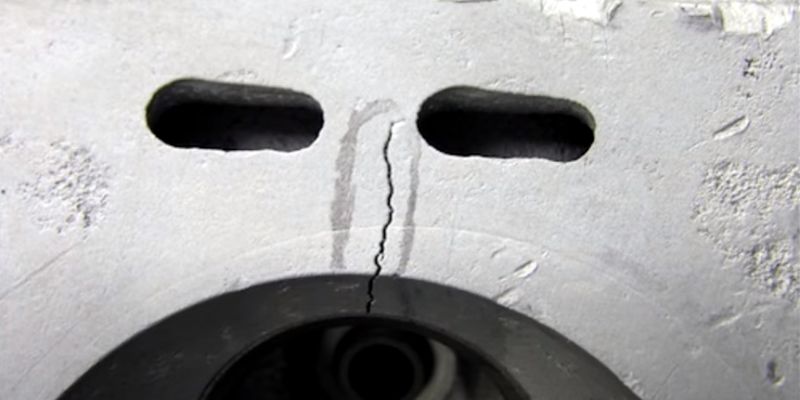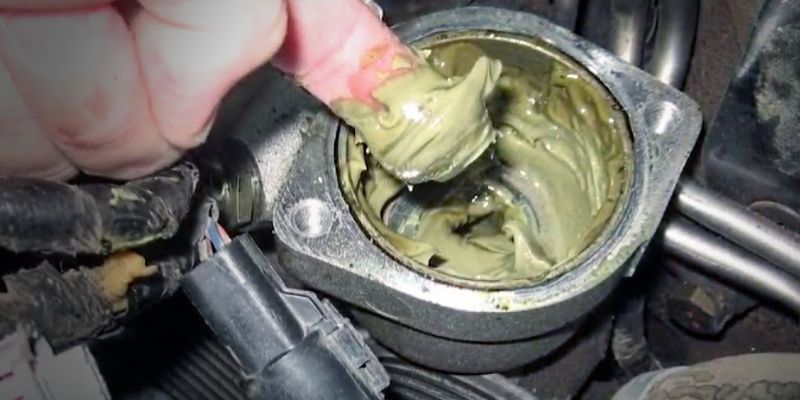Have you noticed your coolant looking milky or cloudy? If so, you’re not alone – a milky coolant is a common issue many car owners face.
In this article, we’ll discuss what causes coolant to turn milky, the potential problems it can lead to, and options for repair. By understanding milky coolant, you can take steps to keep your vehicle’s cooling system in good working order.
What is Milky Coolant?
Milky coolant occurs when the normally clear engine coolant mixed with contaminated oil particles leaks into the cooling system. It takes on a whitish, opaque appearance that resembles milk which is known as milky coolant.
When microscopic air bubbles or combustion gas byproducts like oil penetrate the closed cooling system, they become suspended in the coolant fluid.
This causes light to scatter as it passes through the solution, reflecting back to the observer in a milky or cloudy fashion rather than a clear view of the liquid.
What Causes Coolant To Turn Milky? Could It Be A Leaking Head Gasket?
There are several common causes for milky coolant, with one of the main culprits being a blown or leaking head gasket.
1. Head Gasket Failure
A head gasket failure allows combustion gases like oil to mix with coolant. This creates an emulsion that looks milky white. As combustion byproducts enter the cooling system, they contaminate and discolor the normally clear fluid.
2. Water Pump Failure
A failing water pump can cause coolant to become milky if it is not properly circulating the fluid. The stagnant coolant mixes with air and forms tiny bubbles, giving it a whitish appearance. Without proper flow, hot spots also develop risking overheating.
3. Coolant Mixing Error
Using plain water instead of a water/coolant mix or tap water rather than distilled water can dilute protective additives. This makes the solution more prone to mineral scale deposits that scatter light, appearing milky. Over time, hardness builds up.
4. Cooling System Leaks
External leaks from cracks in the radiator, loose hoses or fittings, or a porous water neck allow air and impurities to enter the enclosed cooling system. The mixing of air and partial pressure changes causes an opaque milky shade to the fluid.
5. Coolant Contamination
Debris entering minor cracks or through unwiped mounting surfaces may include dirt, rust flakes, or residual oils. These foreign materials are suspended in the solution, scattering rays of light and creating a cloudy visual effect reminiscent of milk.
The cylinder head gasket is crucial for sealing the combustion chamber. When it fails, engine oil can leak into the coolant passages or vice versa.
Over time, this mixing of oil and coolant will turn the ethylene glycol-based fluid milky white. A leaking head gasket is a serious issue that requires repair to prevent further contamination and damage.

What Other Issues Could Cause Milky Coolant Beside A Head Gasket?
In addition to a failed head gasket, other potential causes of milky white coolant include a cracked engine block allowing coolant to seep into the oil galley, worn cylinder bores mixing coolant and oil, or a coolant hose leaking internally.
Over time and many heat cycles, these small internal mixings can discolor the entire cooling system and sometimes result in the form of brown coolant that is also formed by the mixing of oil and coolant.
Coolant reservoirs are also prone to cracking and leaking, introducing air and allowing the ethylene glycol to become diluted from water. A diluted coolant will take on a milky appearance.
How Do I Fix Milky Coolant – Flush The System? Replace Hoses? Head Gasket Repair?
The solution depends on the determined cause.
Fixing Minor Coolant mixings
For minor internal mixings, a thorough coolant flush may clear up the appearance, but the system should continue being monitored. A proper coolant flush through the flushing machine fixes the milky coolant issue.
Fixing Massive Coolant mixing
More extensive issues like a cracked cylinder block usually require repairs beyond just a flush. A leaking or blown head gasket nearly always calls for the removal and replacement of the gasket.
Other worn parts may also need attention during the repair. Replacing worn-out coolant hoses is also a good preventative measure when fixing a milky coolant problem.
Proper repairs are important to fully resolve the underlying issue contaminating the coolant.
How to Diagnose the Milky Engine Coolant?
Here are some key things to check when troubleshooting a milky coolant issue:
- Inspect hoses and clamps for cracks, leaks, or loose fittings that may allow air into the system.
- Examine the radiator for cracks in the plastic tanks or core that can introduce air.
- Check the water pump shaft for play and signs it may be failing, affecting circulation.
- Inspect the coolant reservoir cap and overflow/expansion tank for cracks or loose fittings.
- Take a coolant sample for a chemical analysis to detect combustion gas intrusion.
- Test coolant for proper freeze point and pH level – it may need to be replaced.
- Check thermostat is opening fully to allow warm up and maintain operating temp.
- Inspect heating components like water outlets for hairline cracks that introduce air.
- Verify the coolant level and refill as needed with a premixed solution for the correct ratio.
- Drive the vehicle and keep an eye on the temperature gauge for any issues maintaining the operating temperature.
- Consider a pressure/leak-down coolant system test to isolate pressure leaks.
Thoroughly inspecting for air entry points or failed circulation components is key to properly troubleshooting the root cause of the milky coolant appearance.
Cost to fix Milky Coolant Problem
Here are the potential costs involved in fixing a milky coolant issue:
Coolant Flush – $100-200
This involves draining the old coolant and flushing the system multiple times to remove all remnants of the contaminated fluid.
Coolant Replacement – $30-60
Refilling the cooling system with new premixed coolant after flushing. About 2 gallons is typical.
Cooling System Inspection – $50-100
Labor charges for a full inspection to find the root cause of contamination (leak, failing component).
Water Pump Replacement – $300-600
Common fix if the pump is faulty, causing coolant circulation issues. Parts and labor included.
Head Gasket Replacement – $800-1200
Major repair if testing reveals a failed head gasket allowing combustion gases in.
Radiator Replacement – $200-500
Potential fix if leaks are originating from cracks in the radiator core.
Additional Repairs – Variable costs
Such as hoses, thermostats, clamps, etc. if inspection finds other problem areas.
Total labor time is typically 2-4 hours for repairs. Therefore, a basic milky coolant issue might cost $300-600 total depending on the necessary repairs. Head gasket failures or multiple component replacements could push costs up to $1,500-2,500 in a worst-case scenario.
Does Milky Coolant Always Mean Head Gasket?
No, milky coolant does not always indicate a failed head gasket. While a blown head gasket is a common cause of milky coolant, there are some other potential reasons for milky coolant are as dirt contamination, cracked radiator, and improper coolant mixture.
Is My Cooling System Okay If There’s An Oil On The Dipstick But No Milky Coolant?
Just because coolant looks clear doesn’t necessarily mean your cooling system is problem-free. It’s possible to have a leaking head gasket and only see signs of it in the engine oil.
Over many coolant changes, all traces of the contamination could be removed from the reservoir. However, oil is still mixed internally.
Checking the oil dipstick for a milky residue or excess levels is important. Even without milky coolant visible, a compression test may still be needed to check for a possible head gasket leak.

Why Is My Coolant Reservoir Overflowing With Milky Liquid?
Here are a few possible reasons why your coolant reservoir may be overflowing with a milky liquid:
- Head Gasket Failure: This is a common culprit. When the head gasket blows, it allows combustion gases like oil to mix with the coolant, turning it milky. Overheating is also a symptom.
- Crack in the Cooling System: A crack in a hose, radiator, water pump, or reservoir can introduce air which causes the coolant to appear milky. It can also cause the system to overflow.
- Coolant Contamination: Dirt, rust particles, or other debris entering through minor leaks can contaminate the coolant and make it opaque. It overflows as new coolant is added.
- Water Pump Issue: A failing water pump may have trouble circulating coolant properly. This leads to localized overheating and mixing of the coolant with air or combustion byproducts.
- Improper Coolant Mixture: Using straight water instead of a premixed antifreeze/water solution, or tap water rather than distilled, can dilute protective additives. Using tap water as a coolant causes residue buildup over time.
If the reservoir is overflowing with milky liquid, it’s an indication of coolant system contamination or a leak that needs to be addressed.
Should I Continue Driving With Milky Coolant Or Get It Checked Out?
It’s not advisable to continue driving when the coolant has a milky appearance. The foreign contamination puts your engine at risk of overheating and severe damage.
Once oil mixes with the ethylene glycol-based coolant, it can no longer provide adequate heat transfer properties. Driving with milky coolant greatly increases the chance of your engine overheating on the road.
It’s best to have any milky coolant issue checked by a repair shop as soon as possible to prevent potentially costly repairs down the line. An inspection can pinpoint the root cause.
How Can I Prevent Milky Coolant In The First Place With Proper Maintenance?
To help prevent coolant from turning milky in your vehicle, developing good maintenance habits is key. This includes following the owner’s manual schedule for coolant fluid changes to remove any contaminants before they spread.
Inspecting hoses and other components during routine tune-ups helps catch small cracks or leaks early.
Maintaining proper engine temperatures to prevent thermal stresses also extends part life.
Using an aftermarket extended-life coolant protects against corrosion and water loss compared to conventional green coolant.
Overall, practicing preventative care of your cooling system goes a long way in keeping it functioning properly without discoloring the coolant.
Final Verdict
In summary, a milky appearance in your vehicle’s coolant is a sign that contamination from sources like oil is occurring internally.
While seemingly a minor cosmetic issue, it indicates potential problems if left unaddressed.
By understanding the different causes of milky coolant, their warning signs, and repair or preventative options, concerned car owners can make informed choices to maintain a healthy cooling system.

Joseph Morgan has decades of automotive experience. The Detroit native started restoring classics in the 1970s. He owned a vintage repair shop and authored articles for car magazines. With a 1965 Mustang fastback of his own, Joseph now shares advice through his YouTube channel. From engine swaps to rust repair, his expertise helps preserve automotive history.
